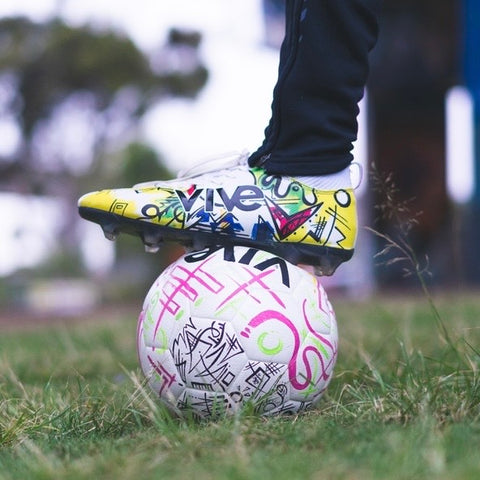
Ultimate Guide to Buying Soccer Balls
As a high performance soccer brand built by a community of real soccer enthusiasts, we know a thing or two about how to make a professional decision when it comes to deciding what soccer ball size do I need?
Below is VIVE's official soccer ball size chart.
CHART: SOCCER BALL SIZES BY AGE
| Size 5 | 27-28" | Adults, Teens, & Pre-Teens (U12+) Ages 11 & up |
| Size 4 | 25-26" | Youth (U8-U11), ages 7-11 |
| Size 3 | 23-24" | Kids ages up to 7 |
SHOULD I BUY A DIFFERENT SIZE SOCCER BALL?
Kids soccer ball sizes can be confusing. If you follow our official size chart, you will be squared away for official game day play.
However, there are times where training with smaller size balls like a 3 or a 4 even after you have "graduated" to a size 5 will help with dribbling skill development. Training with small size balls in tight spaces (outdoor basketball court, garage, or even dribbling thru tight cones on grass) supports quicker feet.

WHAT IS THE DIFFERENCE IN SOCCER BALLS?
Short answer, a lot! The quality and craft of balls are quite disparate in the marketplace, and even balls from the "same old" brands are not going to compare like they should.
We will cover her the most important consideration...
Construction:
- The thermal bonding technology means that the panels are placed inside a mold that is heated by a machine to press and glue the panels together. Thermal bonded ball boasts greater shape retention and durability due to an integrated structure that use special glue to attach the bladder to the lining and leather firmly. Excellent roundness to reduce resistance when flying and rolling, making the ball shoots faster, while the seamless surface allows for less water uptake, helping the ball last in any weather.
- Hand stitching is the most traditional method for making soccer balls. Those early high quality balls were mainly stitched by hand using thick polyester thread to hold the panels together, and that process still has its advantages. The seams can be made at a deeper and stronger level so they’re more wear-resistant than machine-stitched balls, but still can’t prevent the water into the inside of the ball even though using the thicker stitches.
- Machine stitching is a fast and inexpensive technology that is more commonly used for entry-level quality balls. During production, panels are sewed together with a particular sewing machine and tiny micro-stitches. Machine stitched soccer balls are great for younger players because they are lighter in weight, and softer upon impact.

WHAT SOCCER BALLS DO THE PRO'S USE?
If you are looking to play like the best, then play with the best soccer balls. Almost every top competition sanctions thermal-bonded soccer balls (like VIVE's Campeones) for exclusive use in soccer matches from the 2022 World Cup in Qatar to the 2022 Champions League Tournament.
HOW DO I CARE FOR AND WASH A SOCCER BALL?
The most important factor in caring for soccer balls is proper inflation. Top level thermal-bonded soccer balls should never be deflated, this can damage the shape retention. The best way to properly measure the a soccer ball's inflation is with a proper air pressure gauge. Analog gauges work great; not totally necessary to purchase a fancy digital gauge. Many seasoned soccer players may use the "squeeze the ball, drop it on their foot to feel the bounce" trick. This is ok, but not ever accurate particularly since soccer balls come in a wide range of materials in differing densities. Get yourself a simple analog gauge.
We suggest wiping balls down with a damp cloth after play to not allow for dirt or other residue to adhere to the protective layer.
To prolong the life of your soccer equipment, try to stay off the concrete (if you can). However, it is not a big deal if you do not have the access to a proper pitch, just know the protective layer will scuff and scratch. We are totally cool with that, we have all played in the streets and enjoyed some great times with friends.
Lastly, never sit on the ball! We see it happen all the time with kids and adults sitting on the ball while tying their cleats. This will absolutely damage the ball and lose its strength in flight.
STILL HAVE A QUESTION?
No worries, we did too when we first started kicking a ball! We would love to share knowledge and help with any question. Shoot us an email to createfuture@vivecf.com or DM us @vivecreatefuture

